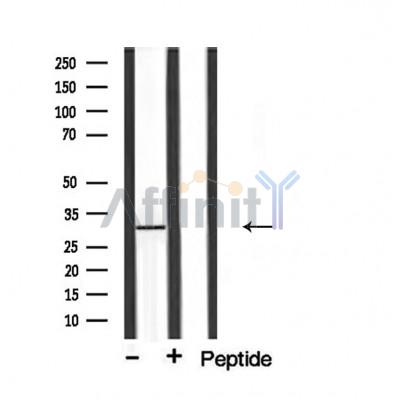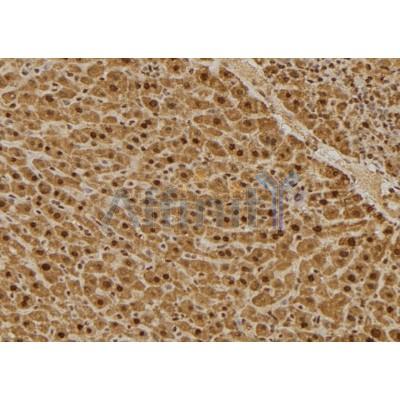产品描述
*The optimal dilutions should be determined by the end user.
*Tips:
WB: 适用于变性蛋白样本的免疫印迹检测. IHC: 适用于组织样本的石蜡(IHC-p)或冰冻(IHC-f)切片样本的免疫组化/荧光检测. IF/ICC: 适用于细胞样本的荧光检测. ELISA(peptide): 适用于抗原肽的ELISA检测.
引用格式: Affinity Biosciences Cat# DF3962, RRID:AB_2836315.
展开/折叠
ASF/SF2 associated protein p32; C1q globular domain binding protein; C1qBP; C1QBP_HUMAN; Complement component 1 q subcomponent binding protein; Complement component 1 Q subcomponent binding protein mitochondrial; Complement component 1 Q subcomponent-binding protein, mitochondrial; GC1Q R; GC1q R protein; GC1q-R protein; GC1QBP; GC1QR; globular domain of, C1q, receptor for; Glycoprotein gC1qBP; HABP 1; HABP1; Hyaluronan binding protein 1; Hyaluronan-binding protein 1; Mitochondrial matrix protein p32; p32; p32 splicing factor; p33; Pre mrna splicing factor SF2 P32 subunit precursor; SF2p32; Splicing factor SF2 associated protein;
抗原和靶标
Expressed on cell surface of peripheral blood cells (at protein level); Surface expression is reported for macrophages and monocyte-derived dendritic cells.
- Q07021 C1QBP_HUMAN:
- Protein BLAST With
- NCBI/
- ExPASy/
- Uniprot
MLPLLRCVPRVLGSSVAGLRAAAPASPFRQLLQPAPRLCTRPFGLLSVRAGSERRPGLLRPRGPCACGCGCGSLHTDGDKAFVDFLSDEIKEERKIQKHKTLPKMSGGWELELNGTEAKLVRKVAGEKITVTFNINNSIPPTFDGEEEPSQGQKVEEQEPELTSTPNFVVEVIKNDDGKKALVLDCHYPEDEVGQEDEAESDIFSIREVSFQSTGESEWKDTNYTLNTDSLDWALYDHLMDFLADRGVDNTFADELVELSTALEHQEYITFLEDLKSFVKSQ
种属预测
score>80的预测可信度较高,可尝试用于WB检测。*预测模型主要基于免疫原序列比对,结果仅作参考,不作为质保凭据。
High(score>80) Medium(80>score>50) Low(score<50) No confidence
研究背景
Is believed to be a multifunctional and multicompartmental protein involved in inflammation and infection processes, ribosome biogenesis, protein synthesis in mitochondria, regulation of apoptosis, transcriptional regulation and pre-mRNA splicing. At the cell surface is thought to act as an endothelial receptor for plasma proteins of the complement and kallikrein-kinin cascades. Putative receptor for C1q; specifically binds to the globular 'heads' of C1q thus inhibiting C1; may perform the receptor function through a complex with C1qR/CD93. In complex with cytokeratin-1/KRT1 is a high affinity receptor for kininogen-1/HMWK. Can also bind other plasma proteins, such as coagulation factor XII leading to its autoactivation. May function to bind initially fluid kininogen-1 to the cell membrane. The secreted form may enhance both extrinsic and intrinsic coagulation pathways. It is postulated that the cell surface form requires docking with transmembrane proteins for downstream signaling which might be specific for a cell-type or response. By acting as C1q receptor is involved in chemotaxis of immature dendritic cells and neutrophils and is proposed to signal through CD209/DC-SIGN on immature dendritic cells, through integrin alpha-4/beta-1 during trophoblast invasion of the decidua, and through integrin beta-1 during endothelial cell adhesion and spreading. Signaling involved in inhibition of innate immune response is implicating the PI3K-AKT/PKB pathway. Required for protein synthesis in mitochondria. In mitochondrial translation may be involved in formation of functional 55S mitoribosomes; the function seems to involve its RNA-binding activity. May be involved in the nucleolar ribosome maturation process; the function may involve the exchange of FBL for RRP1 in the association with pre-ribosome particles. Involved in regulation of RNA splicing by inhibiting the RNA-binding capacity of SRSF1 and its phosphorylation. Is required for the nuclear translocation of splicing factor U2AF1L4. Involved in regulation of CDKN2A- and HRK-mediated apoptosis. Stabilizes mitochondrial CDKN2A isoform smARF. May be involved in regulation of FOXC1 transcriptional activity and NFY/CCAAT-binding factor complex-mediated transcription. May play a role in antibacterial defense as it can bind to cell surface hyaluronan and inhibit Streptococcus pneumoniae hyaluronate lyase. May be involved in modulation of the immune response; ligation by HCV core protein is resulting in suppression of interleukin-12 production in monocyte-derived dendritic cells. Involved in regulation of antiviral response by inhibiting DDX58- and IFIH1-mediated signaling pathways probably involving its association with MAVS after viral infection.
(Microbial infection) Involved in HIV-1 replication, presumably by contributing to splicing of viral RNA.
(Microbial infection) In infection processes acts as an attachment site for microbial proteins, including Listeria monocytogenes internalin B (InlB) and Staphylococcus aureus protein A.
(Microbial infection) Involved in replication of Rubella virus.
Mitochondrion matrix. Nucleus. Cell membrane>Peripheral membrane protein>Extracellular side. Secreted. Cytoplasm. Nucleus>Nucleolus.
Note: Seems to be predominantly localized to mitochondria. Secreted by activated lymphocytes.
Expressed on cell surface of peripheral blood cells (at protein level); Surface expression is reported for macrophages and monocyte-derived dendritic cells.
Homotrimer; three monomers form a donut-shaped structure with an unusually asymmetric charge distribution on the surface. Interacts with CDK13, HRK, VTN, NFYB, ADRA1B, FOXC1, DDX21, DDX50, NCL, SRSF1, SRSF9 and CDKN2A isoform smARF. Interacts with CD93; the association may represent a cell surface C1q receptor. Interacts with KRT1; the association represents a cell surface kininogen receptor. Interacts with CD209; the interaction is indicative for a C1q:C1QBP:CD209 signaling complex. Interacts with FBL and RRP1; the respective interactions with C1QBP are competetive. Probably associates with the mitoribosome. Interacts with MAVS; the interaction occurs upon viral transfection. Interacts with PPIF. Interacts with U2AF1L4. Interacts with PLEKHN1. Interacts with VGF-derived peptide TLQP-21 (By similarity).
(Microbial infection) Interacts with Rubella virus capsid protein; the interaction occurs in mitochondria. Interacts with Rubella virus protease/methyltransferase p150.
(Microbial infection) Interacts with Staphylococcus aureus protein A/spa.
(Microbial infection) Interacts with Staphylococcus aureus protein A/spa, HIV-1 Tat and HCV core protein.
(Microbial infection) Interacts with HIV-1 Tat and HCV core protein.
(Microbial infection) Interacts with L.monocytogenes internalin B.
Belongs to the MAM33 family.
研究领域
· Human Diseases > Infectious diseases: Viral > Herpes simplex infection.
文献引用
Application: IHC Species: Human Sample: Pancreatic Cancer
限制条款
产品的规格、报价、验证数据请以官网为准,官网链接:www.affbiotech.com | www.affbiotech.cn(简体中文)| www.affbiotech.jp(日本語)产品的数据信息为Affinity所有,未经授权不得收集Affinity官网数据或资料用于商业用途,对抄袭产品数据的行为我们将保留诉诸法律的权利。
产品相关数据会因产品批次、产品检测情况随时调整,如您已订购该产品,请以订购时随货说明书为准,否则请以官网内容为准,官网内容有改动时恕不另行通知。
Affinity保证所销售产品均经过严格质量检测。如您购买的商品在规定时间内出现问题需要售后时,请您在Affinity官方渠道提交售后申请。产品仅供科学研究使用。不用于诊断和治疗。
产品未经授权不得转售。
Affinity Biosciences将不会对在使用我们的产品时可能发生的专利侵权或其他侵权行为负责。Affinity Biosciences, Affinity Biosciences标志和所有其他商标所有权归Affinity Biosciences LTD.







